The following contains spoilers for Irma Vep Episode 1, “The Severed Head” (written and directed by Olivier Assayas)
Having recently rewatched Olivier Assayas’s brilliant, confounding 1996 cult classic Irma Vep for an “Off the Shelf” review of the Criterion Collection’s two-disc Blu-ray edition laden with deep-dive special features, I could not have been more excited for HBO’s new remake of the film, debuting with this first of eight scheduled episodes, “The Severed Head.” With Assayas remaking his own material and the lithe, mercurial Academy Award-winner Alicia Vikander starring in the role made famous decades ago by Hong Kong superstar Maggie Cheung, this new Irma Vep—a remake of a remake of a remake of sorts—promises a postmodern, self-reflexive turn on an industry even more in turmoil than it had been in 1996.
As highly as I recommend Criterion’s edition, you don’t need a Blu-ray player to enjoy the original, by the way, as for now HBO Max offers the film via streaming. And you don’t need to know Assayas’s film to enjoy this 2022 remake. But for a brief primer, that 1996 film featured Cheung as an international-superstar actress, a version of herself, arriving in Paris to star in an artsy remake of Louis Feuillade’s 1915 serial Les vampires, this new project helmed by the former Nouvelle Vague great (and now well-past-his-prime) René Vidal (played by New Wave icon Jean-Pierre Léaud). Cheung, all open candor and beguiling humility, can’t quite get a grasp on Vidal’s inchoate intentions; donning an updated version of the skintight black catsuit made famous by Musidora as Feuillade’s burglar Irma Vep (an anagram for vampire), Cheung not only attracts the attention of several co-workers but also begins to adopt some of the iconic character’s traits.
Maggie Cheung wearing the Irma Vep catsuit in the 1996 film by Olivier Assayas.For all of the film’s vaunted self-reflexive considerations of the meaning and importance of cinema in the modern age, Irma Vep is very much a star vehicle for Cheung, who is in nearly every scene and whose character arc is ultimately one of independence. Cast, costumed, directed, lusted after by and for others, Cheung is fetishized both by Assayas’s camera (they later married) and the characters with whom she interacts. But ultimately, her character pursued what was best for herself regardless of others’ intentions, leading to an arc of agency over her life, career, and image. That seems no less timely today as female actors continue to face hypersexualization, typecasting, and harassment.
Assayas’s film also brilliantly deconstructed several of the key tensions inherent in cinema from its origins to the (then-) present day. If the filmmaking process blurs lines between fiction and reality, where does one begin and the latter end? Can an artform based on artifice elicit authenticity? How can one best balance the demands of the industry when they encroach on their personal lives? And how can one aspire to make art when productions are determined by budgets and expenditures beyond their maker’s control?
The fact that these questions remain central to cinema even as they evolve with each new generation, movement, or technology made Irma Vep fascinating in 1996, just as the world of filmmaking has changed dramatically enough since then for Assayas to consider remaking his own work, this time as an eight-episode series and his fictional filmmaker’s adaptation of Feuillade also re-imagined as a series, ostensibly destined for streaming and not a theatrical release. Since #MeToo, since the streaming revolution, since social media, since digital and the internet itself, times, to be blunt, have changed.
So here in 2022 is a new-new Irma Vep. Alicia Vikander plays not herself (as did Cheung) but a disillusioned A-list Hollywood actress, Mira (an anagram for Irma) Harberg (no anagrams there!), fresh off another big-franchise blockbuster superhero role (in the apparently-vacuous-but-commercially-successful Doomsday) and arriving in Paris for what she hopes will be the role that renews her passion for cinema: that of the villainous Irma Vep, a key player in the René Vidal (Vincent Macaigne) remake of Feuillade’s Les vampires.
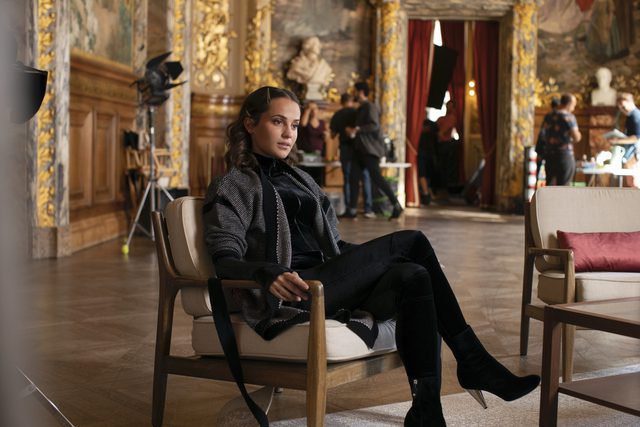
As Episode 1 begins, I’m struck immediately by the vibrant, lovely title sequence announcing its title, “The Severed Head.” Assayas is using the episode titles of Feuillade’s original Les vampires here, and we shall see how closely, if at all, those connect with this new series’ episodes’ content. Trading on imagery of the iconic catsuit made famous first by Musidora and later by Cheung, the hand-drawn animation opens with a catsuit-clad version of Vikander’s character sashaying about the Parisian nightscape, all Eiffel Tower, moonlight, and silhouettes. Her character leaps, bounds, prowls, and catapults about before eventually transmogrifying into a winged batlike creature flying across the screen to the music of Mdou Moctar’s “Ya Habibti.” Streaming services always tempt us with the infernal incitation to “skip intro,” but I’m going to indulge this sprightly, delightful sequence by Stéphane Manel every episode.
Stepping off the plane wearing a stocking cap, shades, and in-vogue travel athleisure, Mira arrives in Paris to be immediately escorted about by drivers and assistants. The new series’ fidelity to Assayas’s film seems pronounced, as the scenes echo Cheung’s 1996 arrival almost exactly. But the series will soon take its own twists and turns. Mira seems almost immediately more direct than Cheung in stating her needs: “I don’t need a hit,” she tells fawning production assistant Regina (Devon Ross), a Vidal-worshipping, Deleuze-reading film-school cinephile. “I want a good movie.”
All appears well for Mira, a little jet-lagged but optimistic, until she learns her former lover Laurie (Adria Arjoni) is here in Paris with her new husband Herman—a secret kept from Mira until now and one that seems to unsettle the actress. Later, we’ll see why. First, there is publicity work to do for the already-a-hit-in-the-U.S.-and -soon-to-be-released-in-France Doomsday, a film in which Mira’s character apparently castrated an adversary. Asked about the film’s ideology, Mira bristles visibly. But on the red carpet, she is all practiced smiles, poses, and poise. Another question has her hackles up when she is asked if she has seen (Feuillade’s) original: Mira clearly does not like having her own cinematic bona fides contested. She has seen it, she claims, more than a little defensively.
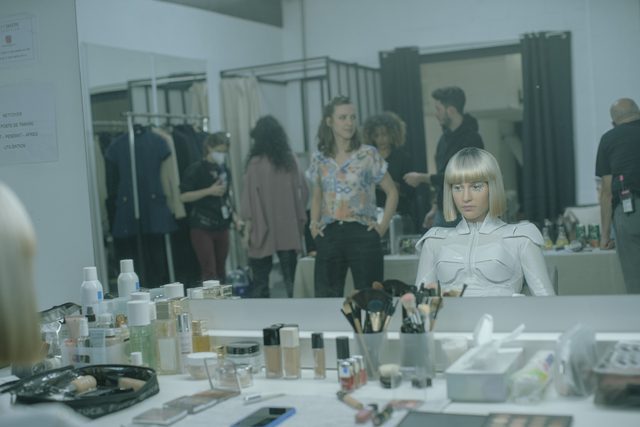
Also at the event: Mira meets Laurie, apparently for the first time since their split, with Laurie having married Herman in the meantime. The two jibe and spar. It’s clear there has been some bad blood—and some hot feeling—in their relationship. There’s really no exact analogue for this relationship or series of events in Assayas’s 1996 film and from its prominence in this opening episode it may be a major plotline moving forward. I hope so: it’s filled with fireworks. The two share a smoke and lean in close. A peeved Mira declares: “You know I’m a better f*ck than Herman!” It’s a claim Laurie does not deny—and one it’s impossible to imagine Maggie Cheung having uttered in 1996.
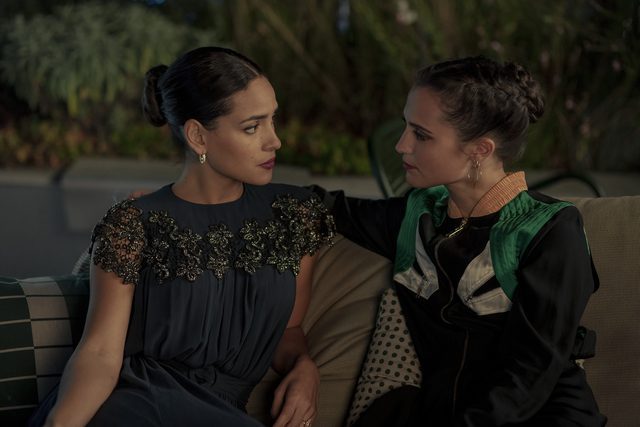
The next day, Regina takes Mira to the set, where she finds René Vidal (Vincent Macaigne) up to his kneecaps, wading about in the muck filming a scene involving a drowned corpse. No stunt casting as there was in Assayas’s 1996 film, which cast Nouvelle Vague icon Jean-Pierre Léaud–the famous Antoine Doinel of François Truffaut’s The 400 Blows and its sequels—as René Vidal. Macaigne is perfectly cast and impactful in these scenes, even if I’m given to wonder who Assayas might have cast if a bit more playfully self-reflexive. Himself, perhaps? Or would he not wish to portray himself as aged and out-of-favor despite his nearly 40 years in the industry? René’s film, it appears, is more of a Victorian period piece, following Feuillade closely. The typical on-set problems ensue as the crew labors to get the scene right.
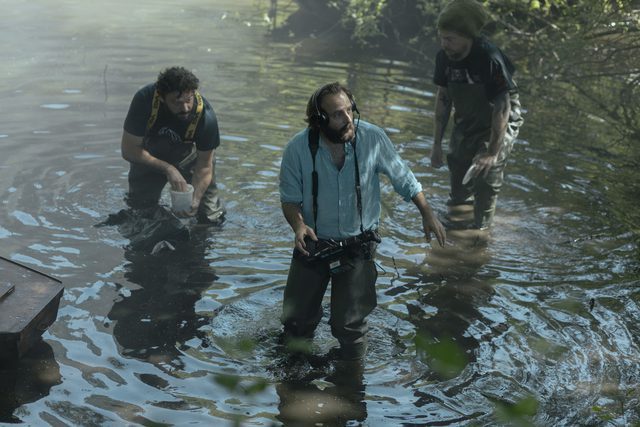
René’s halting English does not impede his and Mira’s communication. He says she “glows.” Mira says she is a fan. Even if he sounds less than confident about his aspirations—saying “I don’t really care about movies” and later “I’m never happy” and “There is no plan”—the two seem to bond over their appreciation for Musidora, the actress who made the Irma Vep character so iconic in 1916. “She was an outlaw and so are we,” he tells Mira. Even if René seems less than confident in his project, his relationship with his star looks to be off to a promising start.
This being a remake, if that’s the right term, of Irma Vep, there is of course, then, that catsuit. What would any self-respecting Irma Vep be without it?
Mira is offered one of several costume prototypes, this made with a velvety, stretchy fabric that catches and reflects light, and for a first attempt, as she notes, the result is frankly pretty spectacular. Mira dons the suit and seems almost immediately transformed: Vikander, who trained as a ballet dancer at the Royal Swedish Ballet in her native Sweden and later left a promising career in dance for the screen due to injuries, improvises a catlike prowl up a staircase and out of sight of her costumers. Apparently already feeling the cat-burglar instincts of her iconic character, she stealthily pilfers a credit card from a purse—one the superstar actress can’t possibly need—before returning. Assayas has wasted little time in suggesting that Mira will feel the influence of the catsuit and the Irma Vep character in ways that are likely to escalate.
In one subplot featuring the cast members, Edmond (Vincent Lacoste) tries to negotiate additional scenes, ostensibly for his own character’s motivation, but also with the intent of re-enacting sex with his former lover/co-star. He pleads with her that he will even advocate for the hire of an intimacy coordinator—something no production had (but many needed!) in the mid-1990s and before. Another subplot involves René’s dependence on powerful mood stabilizers and his having had disclosed such to the production’s insurers, a mistake that may come back to haunt him and his plans for Les vampires. René had, after all, tried to run over his lead actor with his car on an earlier production. Despite his talent, he’s a risk, and not only to his insurers, who are now adamant: they won’t underwrite this project.
But the real action heats up when Laurie arrives on set to visit Mira. Mira, dressed in her catsuit, arouses Laurie’s desires, and Laurie covertly if overtly initiates some command over the star for whom she once worked. “I know you,” she tells Mira, “and you’re turned on.” She gazes intently like a sadistic hypnotist (there was one, by the way, in Les vampires!) and begins a series of commands: “Sit back. Put your hands on the armchair. Lean back. Open your legs. Not too much.”
Mira complies. If Mira is turned on, so, clearly, is Laurie. She pauses, opens her mouth to inhale, lowers her gaze, and, satisfied, says “There.”
“Like this?” asks Mira, returning her gaze. Laurie asks, “Do you want me back? Say it.” Mira does, if with some defiance to her tone. Abruptly, Laurie takes leave, and the two make a date to meet at the Plaza tonight “for a drink” Laurie says, though she is pretty clearly implying more than that as she strokes Mira’s chin. “I know you’ll be there,” she declares, as she exits.
Whew!
In the meantime, the production continues, with the cast increasingly exasperated by their characters’ lack of motivation. Why would he give her a poison ring? Fair enough: the new production seems little more than an echo of the original, a 1910s serial that eschewed any character development or psychology for a wildly melodramatic thriller ride of twists and turns. A visibly disappointed Regina relents when Mira says she’s staying “for a meeting.” And Laurie is late.
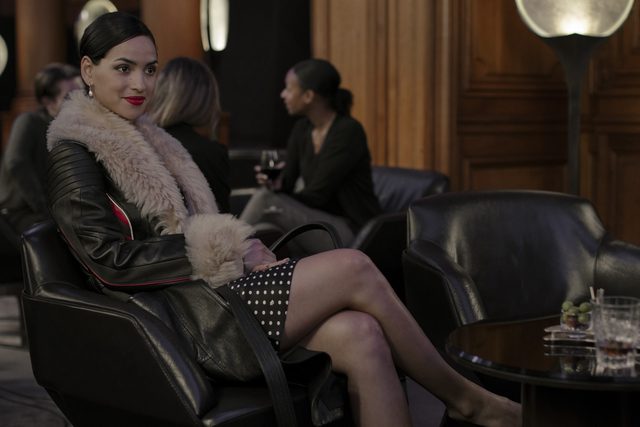
Turns out it’s a power play. Laurie keeps Mira waiting for the better part of an hour. And when she arrives, she is dressed to the nines. Or tens. Maybe elevens. Mira takes immediate notice, even though she is not used to being kept waiting. Laurie reminds Mira that she spent many an hour waiting on the star in their past relationship. Was there more? Did Mira abuse that power she held over her assistant? How much revenge will Laurie exact?
Abruptly, Laurie ends that date without the promised drink. She’s off for an evening with Herman. And Mira is left alone, without much more than a final, pathetic epithet to deliver: “F*ck you, Laurie,” she says, again a blunt expression unimaginable from Maggie Cheung’s character an era or three prior.
It’s clear this 2022 Irma Vep is going places Assayas and Cheung had not in 1996. More than a mere update, the eight-episode structure should allow for some diversion and expansion. Already, we’ve seen a blunter, firmer protagonist and gained more of a backstory for her than in the film version. With Laurie’s revenge and marriage, her and Mira’s palpable sexual chemistry, Regina’s desires, and René’s on- and off-set difficulties, Assayas is promising HBO and HBO Max subscribers plenty to sink their teeth into. His new Irma Vep won’t be the same as the one that launched his international reputation in 1996, but to judge from this first episode, it promises to be a wild ride through a troubled production and several thorny relationships.
Episode 2 of Irma Vep, “The Ring that Kills,” airs Monday, June 13, on HBO and HBO Max.

